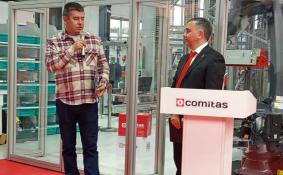Scientific & Practical Journal

Editorial News
Dear readers! We are pleased to present to you the eleventh issue of the journal in 2025. There are a lot of relevant and useful materials in the issue, which, hopefully, will not be ignored.
Dear readers! In September the CeMAT RUSSIA exhibition was held, which showed everyone that innovations and robotics are increasingly penetrating the logistics industry. We can safely say that many technologies are tested here, and only then they go out into the world. However, it is not only CeMAT RUSSIA that demonstrates the prevalence of the digital agenda.
Dear readers! This is the ninth issue of the journal, which turned out to be very rich and diverse. Traditionally, the issue is opened by an analyst. The material by Alina Nasyrova from the Market Guide Agency, dedicated to investments in warehouse complexes in Russia, recalls the importance of developing logistics infrastructure for the integrated development of regions.
PHOTO OF THE WEEK
CITATIONS
All News of Logistics
Flexible mobility services for Finland and Europe on a one-stop-shop principle
VTT Technical Research Centre of Finland Ltd is coordinating a Pan-European Mobility as a Service (MaaS) project for creating the prerequisites for organising user-oriented and ecological mobility services. The goal is to provide consumers with flexible, efficient and user-friendly mobility services covering multiple modes of transport on a one-stop-shop principle.
MAASiFiE (Mobility As A Service For Linking Europe) is a two-year project, which, in addition to mobility services, is investigating the opportunities of combining passenger and freight transport operations, especially with respect to urban delivery and distribution in rural areas.
MaaS services could, for example, enable users to better manage their overall transport needs, for example purchasing a combination of long-distance and commuter trips under one fare on the same ticket. As well as traditional public transport, MaaS could also cover various rental and sharing services.
In the future MaaS operators would handle the construction of travel chains and the monetary transactions between various actors. Multimodal route planners would also support the provision of MaaS services. The exploitation of mobile devices would be comprehensive, also in the provision of payment services.
From the viewpoint of transport and ICT operators, the changes are mainly manifested in new collaboration practices and business models. The project emphasises the roles of transport authorities, operating environments and actors, as well as the impact of legislation on putting the MaaS services into practice.
Mobility services are expected to increase the use of public transport, car sharing and ride sharing, etc., and to provide the means for rationalising passenger and freight transport operations. This would in turn reduce traffic volumes, emissions and congestion.
The project is funded by the Conference of European Directors of Roads and the following CEDR member countries: Finland, Germany, Norway, the Netherlands, Sweden, the UK and Austria. The other consortium partners are Chalmers University of Technology, Sweden, and AustriaTech, Austria. The steering committee consists of the Finnish Transport Agency and the Swedish Transport Administration.












